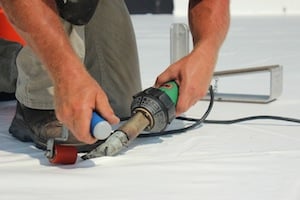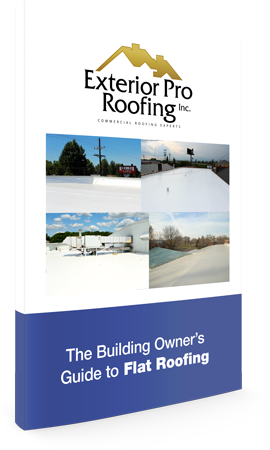Low-slope roofing is classified as applying a water-impermeable, or weatherproof, roofing membrane to a roof sloping less than or equal to 14 degrees.

Selection of a roofing membrane for these roofs is a very important decision for building owners. Reason being, water drainage doesn’t happen as effectively as with steep-sloped roofs, and the roof may be subjected to heavier loads and foot traffic.
As a result, the roofing membrane that you select needs to be watertight, weather resistant and durable.
Below we’ll walk you through the five generic classifications of low-slope roof membrane or systems to help as you discuss your roof options with your contractor.
Built-Up Roof (BUR):
Built-up roofing membranes are composed of alternating layers of bitumen and reinforcing fabrics.
- Reinforcing fabrics, called “felts” or “ply sheets” are typically constructed of glass fiber mats or felts (organic or synthetic) saturated with bitumen by the manufacturer.
- Bitumen is typically asphalt or coal tar heated to a viscosity where it can be mopped or mechanically spread.
This roof membrane is assembled onsite, applied directly to the roof deck, insulation, or over a mechanically attached base sheet.
The surface of this membrane is typically gravel, slag or mineral granules embedded in hot asphalt or a cold-applied adhesive.
Metal Panel Systems:
There are two main types of metal panel roofing systems: architectural and structural. Structural metal panel systems are used for flat roofs because of their strength and hydrostatic (water-barrier) characteristics.
These roofs are ideal for buildings with large gaps between structural supports, as may be the case in large factory buildings. They are mechanically fastened to the roof support structures.
Polymer-Modified Bitumen Sheet Membranes:
Modified bitumen membranes are manufactured sheets comprised of bitumen (typically asphalt) that has been modified with some sort of polymer—either atactic polypropylene (APP) or styrene butadiene styrene (SBS). These modifiers give the sheets plasticized or rubberized qualities respectively.
The sheets are typically heat welded together, applied with a cold adhesive or come with self-adhering backs. They are generally installed over an asphalt or modified asphalt base sheet, another modified bitumen membrane, or a 2- or 3-ply BUR.
Single-Ply Membranes:
Single-ply membranes are factory-manufactured sheets generally categorized as either:
- Thermoplastic: Material that can be repeatedly softened when heated and hardened when cooled.
- Thermoset: Material that solidifies irreversibly by molecular cross linking after heating.
The sheet’s thickness is measured in mils, where 1 mil equals 0.001 inch. Common mil thickness is between 30 and 60 mils, but can be thicker.
These roofing systems can be installed by any of the following methods: fully adhered, mechanically attached, ballasted or protected membrane roof assembly. This gives contractors to flexibility to install in any type of weather.
Spray Polyurethane Foam-Based (SPF) Systems:
SPF is a fully adhered roofing system that consists of two components: a layer of foam insulation and protective surfacing.
The foam is composed to two components—isocyanate and polyol—which are heated and pumped to a roof in one-to-one ratio. A spray gun then mixes to two components and applies them to a substrate.
The protective surfacing is an elastomeric coating that is typically sprayed on, but can be applied by hand or power roller. This coating provides weatherproofing, protects the foam from UV exposure, protects against mechanical damage, and assists with fire resistance.
Work with your roofing contractor to select the membrane that is ideal for the weather and traffic your roof will be subjected to, while cost effective enough to stay within your budget.
Everything Building Owners Need to Know When Selecting a Roof
It's all in this free ebook, The Building Owner's Guide to Roofing. In it, you'll learn how to select the best contractor, roofing membrane and warranty for your needs. Download it today.







